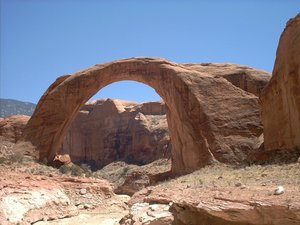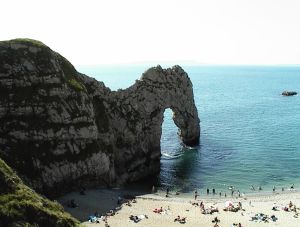Natural arch
|
|

A natural arch or natural bridge is a formation (or landform) where a rock arch forms, with a natural passageway through underneath. Most natural arches form as a narrow ridge, walled by cliffs, become narrower from erosion, with a softer rock stratum under the cliff-forming stratum gradually eroding out until the rock shelters thus formed meet underneath the ridge, thus forming the arch. Natural arches commonly form where cliffs are subject to erosion from the sea, rivers or weathering (sub-aerial processes); the processes "find" weaknesses in rocks and work on them, making them bigger until they break through.
(The choice of "bridge" vs "arch" is somewhat arbitrary. The Natural Arch and Bridge Society identifies a bridge as a subtype of arch that is primarily water-formed and flat on top.)
| Contents |
Coastline arches
On coasts this can form two different types of arch depending on the geology. On discordant coastlines, where rock types run at 90° to the coast, headlands form. Wave refraction concentrates the wave energy on the headland, and the arch forms when caves break through the headland, e.g., London Bridge in Victoria, Australia. When these eventually collapse they form stacks and stumps. On concordant coastlines, where rock types run parallel to the coastline, with weak rock (such as clay) protected by stronger rock (such as limestone) the wave action breaks through the strong rock and then erodes the weak rock very quickly. Good examples of this are at Durdle Door (illustration, above) and Stair Hole near Lulworth Cove on the Dorset Jurassic Coast in south England. When Stair hole eventually collapses it will form a cove.
Wind eroded arches
Arch_form.gif
Sequence of arch formation
- Deep cracks penetrated into a sandstone layer.
- Erosion wore away exposed rock layers and enlarged the surface cracks, isolating narrow sandstone walls, or fins. Alternating frosts and thawing caused
- crumbling and flaking of the porous sandstone and eventually cut through some of the fins.
- The resulting holes were enlarged to arch proportions by rockfalls and weathering. Arches eventually collapse, leaving only buttresses that in time will erode.
Many of these arches are found within Arches National Park in Utah.
Water eroded arches
Some natural bridges may look like arches, but they form in the path of streams that wear away and penetrate the rock. Pothole arches form by chemical weathering as water collects in natural depressions and eventually cuts through to the layer below.
Natural Bridges National Monument is a superb place to view these bridges.
Cave erosion
London_arch.JPG
Natural bridges can form from natural limestone caves, where paired sinkholes collapse and a ridge of stone is left standing in between, with the cave passageway connecting from sinkhole to sinkhole.
Like all rock formations, natural bridges are subject to continued erosion, and will eventually collapse and disappear. One example of this was the double-arched Victorian coastal rock formation, London Bridge which lost an arch after storms increased erosion.
See also
- Ayres Natural Bridge State Park (Wyoming)
- Étretat (France)
- Kolob Arch
- Llanrhaeadr-ym-Mochnant (Wales)
- Percé Rock
- Pont d'Arc
- Natural Bridge State Park (Kentucky)
- Natural Bridge, Virginia
- Bridge
- Tassili n'Ajjer
- Sewanee Natural Bridge
External link
- The Natural Arch and Bridge Society homepage (http://www.naturalarches.org/)

